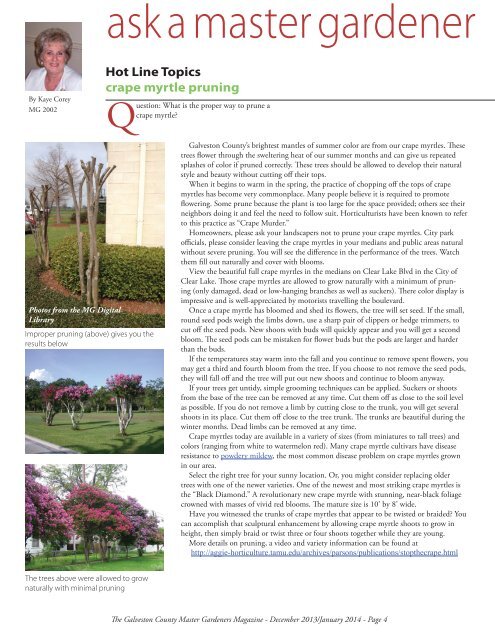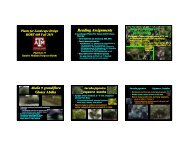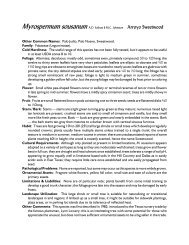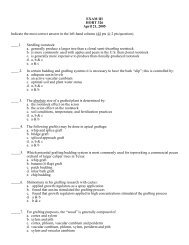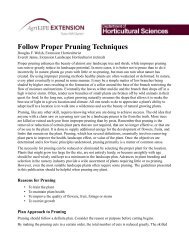Bulb Gardening - Aggie Horticulture - Texas A&M University
Bulb Gardening - Aggie Horticulture - Texas A&M University
Bulb Gardening - Aggie Horticulture - Texas A&M University
You also want an ePaper? Increase the reach of your titles
YUMPU automatically turns print PDFs into web optimized ePapers that Google loves.
ask a master gardenerBy Kaye CoreyMG 2002Hot Line Topicscrape myrtle pruningQuestion: What is the proper way to prune acrape myrtle?Photos from the MG DigitalLibraryImproper pruning (above) gives you theresults belowGalveston County’s brightest mantles of summer color are from our crape myrtles. Thesetrees flower through the sweltering heat of our summer months and can give us repeatedsplashes of color if pruned correctly. These trees should be allowed to develop their naturalstyle and beauty without cutting off their tops.When it begins to warm in the spring, the practice of chopping off the tops of crapemyrtles has become very commonplace. Many people believe it is required to promoteflowering. Some prune because the plant is too large for the space provided; others see theirneighbors doing it and feel the need to follow suit. Horticulturists have been known to referto this practice as “Crape Murder.”Homeowners, please ask your landscapers not to prune your crape myrtles. City parkofficials, please consider leaving the crape myrtles in your medians and public areas naturalwithout severe pruning. You will see the difference in the performance of the trees. Watchthem fill out naturally and cover with blooms.View the beautiful full crape myrtles in the medians on Clear Lake Blvd in the City ofClear Lake. Those crape myrtles are allowed to grow naturally with a minimum of pruning(only damaged, dead or low-hanging branches as well as suckers). There color display isimpressive and is well-appreciated by motorists travelling the boulevard.Once a crape myrtle has bloomed and shed its flowers, the tree will set seed. If the small,round seed pods weigh the limbs down, use a sharp pair of clippers or hedge trimmers, tocut off the seed pods. New shoots with buds will quickly appear and you will get a secondbloom. The seed pods can be mistaken for flower buds but the pods are larger and harderthan the buds.If the temperatures stay warm into the fall and you continue to remove spent flowers, youmay get a third and fourth bloom from the tree. If you choose to not remove the seed pods,they will fall off and the tree will put out new shoots and continue to bloom anyway.If your trees get untidy, simple grooming techniques can be applied. Suckers or shootsfrom the base of the tree can be removed at any time. Cut them off as close to the soil levelas possible. If you do not remove a limb by cutting close to the trunk, you will get severalshoots in its place. Cut them off close to the tree trunk. The trunks are beautiful during thewinter months. Dead limbs can be removed at any time.Crape myrtles today are available in a variety of sizes (from miniatures to tall trees) andcolors (ranging from white to watermelon red). Many crape myrtle cultivars have diseaseresistance to powdery mildew, the most common disease problem on crape myrtles grownin our area.Select the right tree for your sunny location. Or, you might consider replacing oldertrees with one of the newer varieties. One of the newest and most striking crape myrtles isthe “Black Diamond.” A revolutionary new crape myrtle with stunning, near-black foliagecrowned with masses of vivid red blooms. The mature size is 10’ by 8’ wide.Have you witnessed the trunks of crape myrtles that appear to be twisted or braided? Youcan accomplish that sculptural enhancement by allowing crape myrtle shoots to grow inheight, then simply braid or twist three or four shoots together while they are young.More details on pruning, a video and variety information can be found athttp://aggie-horticulture.tamu.edu/archives/parsons/publications/stopthecrape.htmlThe trees above were allowed to grownaturally with minimal pruningThe Galveston County Master Gardeners Magazine - December 2013/January 2014 - Page 4


